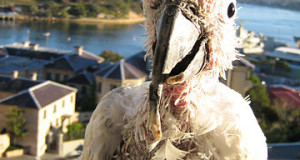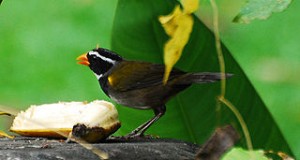 The act of holding up or pointing to an object, in order to draw another’s attention, has been observed only among ourselves and Great Apes. Known as deictic gesturing, this behavior is considered critical to the development of language, and a sign of great intelligence (you parents will likely recall the first time your toddler did something similar!). Along with parrots, crows, and magpies, Common Ravens, Corvus corax, have proven themselves among the brightest of the world’s birds. Recently, they have been observed to utilize deictic gestures, and are the only birds known to do so.
The act of holding up or pointing to an object, in order to draw another’s attention, has been observed only among ourselves and Great Apes. Known as deictic gesturing, this behavior is considered critical to the development of language, and a sign of great intelligence (you parents will likely recall the first time your toddler did something similar!). Along with parrots, crows, and magpies, Common Ravens, Corvus corax, have proven themselves among the brightest of the world’s birds. Recently, they have been observed to utilize deictic gestures, and are the only birds known to do so.
“Hey…look at this if you care about me”!
Researchers at the Max Planck Institute for Ornithology and the University of Vienna have reported that Ravens pick up objects such as stones, branches and moss and show them to other Ravens. In most cases, the bird being solicited is the other’s mate. Once his or her attention is drawn, the pair usually jointly manipulates the object for a time.
Pair formation in Ravens is a long, complicated process, and mated birds are known to engage in complex tasks that require a high level of cooperation. This, and their intelligence, was long ago recognized by people living within their range. In the northern reaches of North American and Asia, Ravens featured prominently in mythology and folklore. Ornithologists believe that showing and jointly “handling” objects may be used to test the suitability or interest of a potential mate, and to strengthen the bond once the birds have paired up.
Parrots and Crows Ace Tests
Several other interesting studies concerning avian intelligence have been published recently. Most have focused on Parrots and Corvids (Crows, Magpies, and Ravens). Believed to be the most intelligent of all birds, the learning abilities of both groups have shocked researchers. In some test situations, New Caledonian Crows have scored on par with Chimpanzees and other Great Apes.
The articles linked below describe some of what these brilliant avian test-takers have accomplished recently – Keas that learn and build upon problem solving skills and discard them when need be, Japanese Crows that take advantage of both traffic and traffic signals when feeding, African Gray Parrots that pick and choose human words to fit specific situations, and more…
Further Reading
Do Parrots Know what they are Saying? (Yes, at least some of the time!).
Raven image referenced from wikipedia and originally posted by Franco Atirador
Chihuahuan Raven image referenced from wikipedia and originally posted by Aaron
 That Bird Blog – Bird Care and History for Pet Birds
That Bird Blog – Bird Care and History for Pet Birds



